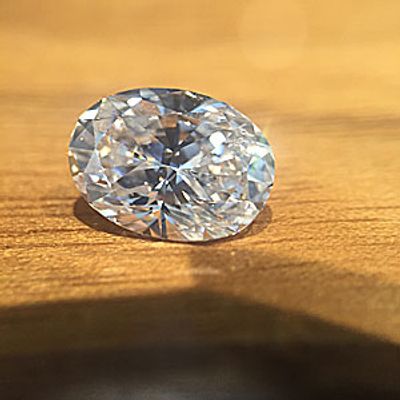The Four C's
The 4C’s are essential to determining the value of any polished diamond. They are; Color, Clarity, Carat, and Cut.
Color is measured by the eye under strict lighting conditions and graded on a scale from D – Z. D is the highest color grade. D colors have the least amount of color present in a diamond. All proceeding grades, E, F, G…Z, represent the gradual increase of color with in the diamond. Diamonds are color graded loose (unset), on a pure white surface. It is important that the gem is graded table side down; the brilliance of the diamond makes it much too difficult to judge the color table side up. For many year the industry considered diamonds in the D, E, and F color grades as “colorless” and G, H, I, J as “near colorless”.
The Clarity scale measures the overall impact of all visual impurities within a diamond at ten times magnification. The scale most commonly used was created by the GIA:
Flawless (FL), diamonds devoid of any visible imperfection at 10X within the gem and any blemish (i.e. a sratch or polish lines) on its surface. This is often very difficult to produce because the cutting wheel often leaves very fine polish lines.
Internally Flawless (IF). No visible imperfection at 10x magnifcation.
Very Very Slightly Included 1 (VVS1), VVS imperfection are very small and hard to to see at 10X
Very Very Slightly Included 2 (VVS2)
Very Slightly Included 1 (VS1)
Very Slightly Included 2 (VS2)
Slightly Included 1 (SI1)
Slightly Included 2 (SI2)
Imperfect 1, 2, and 3 (I1, I2, I3). Generally, diamonds SI2 and higher appear “clean” to the naked eye and it is very difficult for an untrained individual to find an inclusion in VS1 or higher clarities graded diamonds, even under ideal lighting and extreme magnification.
Carat (1 cts. = 0.2 grams) is the easiest factor to determine. It is simply the weight of the diamond to the nearest hundredth of a carat. Carat weight can greatly effect value, the larger the rough diamond the more rare it is, thus per carat price of polished diamonds increases in relation to weight.
Cut, this has been traditionally the hardest C to define. It encompasses two ideas: the first is simple, it is the overall shape of the diamond and facet arrangment: Round Brilliant, Emerald Cut, Pear Shape, Princess Cut, Radiant Cut, Marquise Cut, Cushion Cut and Asscher Cut to name the most common. The second, much more difficult to define, is how the the number, size and angle of each facet affects the gems use of light, i.e. brilliance, scintillation and dispersion. The angles at which the facets of a diamond are cut in relation to its table and the size and length of certain facets greatly affect its appearance.
The GIA grades Cut only for Round Brilliant diamonds. After several years of research, computer modeling and observation, GIA has created a system to measure the performance of light within a diamond. GIA uses simple nomenclature to grade cut: Excellent, Very Good, Good, Fair and Poor. It is important to note that GIA uses the same terms to describe both Polish; how well each facet has been polished, i.e. scratches or polish lines and Symmetry how symmetrical the facets are to each other. Polish and symmetry are measures on all shapes, however, for now GIA has only been effective in creating a Cut Grade for Round Brilliant diamonds. The outline and length to width ratio of most other shapes have to great of an acceptable variance for anyone to scientifically define the quality of the cut. Sometimes its hard for science to define beauty. After all, maybe beauty really does lie in the eyes of the beholder. Square cut diamonds such as Princess Cuts, which have a very small variance in length to width ratio, will most probably be the next shape to be added to the GIA cut grade system.

Diamond Cutters, Rehs Co, Inc. Oval Diamond
What You should know about Fluorescence
Some diamonds (25%- 35%) fluoresce when expose to UV light. Most often diamonds fluoresce (glow) a light to strong blue color. It is actual amazing the first time you see it. Diamonds in mid to lower color ranges that are fluorescent can appear "whiter" due to the optical effect of the blue fluorescence. However, UV light from the sun or other sources can make a very limited number of fluorescent diamonds appear a little hazy or "milky", thus detracting from the brilliance of that diamond. The industry over the last twenty years has begun to discount fluorescence diamonds. Discounts increase in direct relation to the intensity of fluorescence. The GIA has done some thorough research on the subject and has printed some surprising results.
" Simply put, blue fluorescence had a negligible effect on the face-up appearance of diamonds in the colorless or near-colorless grade ranges (grades D through J) except for a slight improvement in the rare instances of very strong fluorescence intensity. " https://4cs.gia.edu/en-us/blog/diamond-fluorescence-good-bad/
The full GIA: Gems and Gemology article is available as a PDF file at https://www.gia.edu/gems-gemology/winter-1997-fluorescence-diamonds-moses

Gemological Institute of America
https://4cs.gia.edu/en-us/blog/diamond-fluorescence-good-bad/
Copyright © 2020 Rehs Co, Inc. - Diamond Cutters - All Rights Reserved.
212-750-6163 Info@rehsdiamonds.com Wholesale Only
